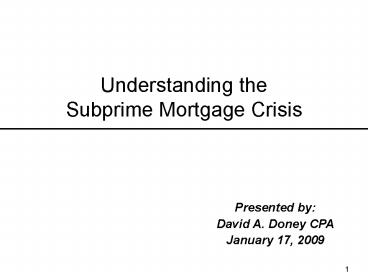Understanding the Subprime Mortgage Crisis - PowerPoint PPT Presentation
1 / 12
Title:
Understanding the Subprime Mortgage Crisis
Description:
Expectation that refinancing available. Consumption culture. High ... Lower Interest Rates. Stimulus package ($170 B so far) Close ' ... Minimum home down ... – PowerPoint PPT presentation
Number of Views:70
Avg rating:3.0/5.0
Title: Understanding the Subprime Mortgage Crisis
1
Understanding theSubprime Mortgage Crisis
Presented by David A. Doney CPA January 17, 2009
2
Housing Bubble Formation Systemic Fragility
Lending Decisions by Institutions
Borrowing Decisions by Homeowners
- Speculation / Mania behavior
- High-risk mortgage types (ARM)
- Expectation that refinancing available
- Consumption culture
- High personal debt levels
- Home ATM machine
- Free lunch mentality
- Home perceived a secure investment
- Easy credit environment (2001-04)
- Pressure on Fannie Freddie
- Erroneous credit ratings
- Conflicts of interest incentives
- High bank leverage / debt
- Too Big to Fail
- Complex financial instruments
- Interconnection / globalization
- Shadow banking system
- Outdated regulatory regime
- Made in America
3
Subprime Mortgage Crisis Domino or Ripple Effect
Housing Market
Housing Prices Fall
Defaults Foreclosure
Cannot Refinance
Wealth Construction Pressure
Financial Markets
MBS Value Declines
Bank Losses Failures
Tighter Credit
Wealth Investment Pressure
MBS Mortgage-backed security. Think of it as
a bet on housing prices and mortgage payments
when they fall, the value of the MBS falls.
Banks had bet heavily on housing via MBS.
4
Vicious Cycles of Foreclosure and Bank
Instability
Cycle 1 Voluntary or involuntary foreclosures
increase the supply of homes, which lowers home
prices creating further negative equity. Cycle
2 Foreclosures reduce the cash flowing into
banks and the value of mortgage-backed securities
(MBS) widely held by banks. Banks incur losses
and require additional funds (recapitalization).
If banks are not capitalized sufficiently to
lend, economic activity slows and unemployment
increases, which further increases foreclosures.
Housing Prices Decline
Negative Equity (Home worth Less than mortgage)
Banks Incur Losses
Mortgage Payments Decline
Value of MBS Declines
1
Homeowners Walk Away or Involuntary Foreclosures
Increase
2
Bank Capital (Loanable Funds) Declines
Banks Restrict Lending
Economic Activity Slows Unemployment Increases
Increased Supply of Homes
Source Wikipedia Subprime Mortgage Crisis
5
Responses Solutions (So Far)
- Financial Markets Economy
- Recapitalize the banks / 700 Billion Bailout
(TARP or EESA) - Credit Easing Fed provides loans against
various types of collateral - Investments, not expenses! But will they pay
off? - Bailout institutions if Too Big to Fail AIG,
Fannie, Freddie, Citi - Lower Interest Rates
- Stimulus package (170 B so far)
- Close Zombie Banks
- Housing Markets (Much More to Do Here!)
- Freeze / delay ARM adjustments foreclosures
- Refinance mortgages (loan balances, payment
terms) - Systematic homeowner assistance
So Far 7.2 Trillion Allocated and 2.7 Trillion
Invested / Spent
6
Long-Term Solutions Risks
- Overhaul Regulations to Limit Risky Behavior
- Minimum home down payments (20)
- Restrict debt / leverage / types of bets for
major financial institutions - Eliminate Risk Concentration
- Address Too Big to Fail regulate / break up
financial conglomerates - Wind-down Fannie Mae Freddie Mac
- Risks Implications
- Not doing enough vs. increased deficits / debt
- Taxpayer losses on Fed loans
- Moral hazard (privatized gains, but socialized
losses) - Deflation or Inflation
- Loss of national credibility influence
- Protectionism and income distribution
- Slower or declining economic growth
- Living within our means
- Create, instead of living off the buying and
selling of others
7
Demographics
One of the main drivers of long-term fiscal
position is changing demographics. Social
Security and Medicare are facing enormous
deficits.
2040 2.1 to 1
Today 3.3 to 1
1960 5.1 to 1
Source Social Security Administration, April
2007 Slide Concord Coalition
8
The Risks of Growing Entitlement Spending
Sometime between 2030 and 2040, mandatory
spending will exceed government revenues.
Source GAO Citizens Guide 2007
9
Medicare Medicaid to GDP
Source Congressional Budget Office
10
Social Security Changes to match tax revenue to
cost
Payroll Tax Rate ()
Expense Reductions ()
22
16.0
14.1
12.4
11
Today
2041
Today
2041
Tax Rate
Source Data Social Security Administration
11
Principles - U.S. Federal Financial Position
- Moral We are shifting our burden to future
generations - Current fiscal path policies are unsustainable
- We cannot grow our way out of this (GAO)
- Fraud, waste, abuse, and earmarks are minimal
- Mandatory programs must be reformed
- Borrowing from foreign countries affects our
sovereignty - Delays mean more significant changes required
- There are few free lunches--We have to choose
between reducing benefits and increasing taxes - Bi-partisan cooperation with all options on the
table will be required
See Wikipedia Subprime mortgage crisis
United States Federal Budget New York Times -
The Reckoning Series Morris, Charles The
Trillion Dollar Meltdown Bittle Johnson Where
Does the Money Go?
12
Appendix Some Key Statistics
- Housing Market and Consumers
- Between 1997 and 2006, U.S. home prices increased
124. - USA household debt to income ratio 199077 /
2007127. - 1991-2001 home prices ranged from 2.9 3.1
times median household income they rose to 4.0X
in 2004 and 4.6X in 2006. - In 2004-2005, 40 of purchases were 2nd homes,
versus typical 20. - In 2005, the median down payment was 2 43 made
none. - Financial Institutions
- Subprime mortgages were less than 10 of total in
2001-2003. - They jumped to 18-21 from 2004-2006.
- Financial institutions borrowed heavily to bet on
housing prices - Fannie May Freddie Mac 5 trillion in debt
- Top 5 Investment banks 4 trillion in debt
- Not regulated like depository banks






























